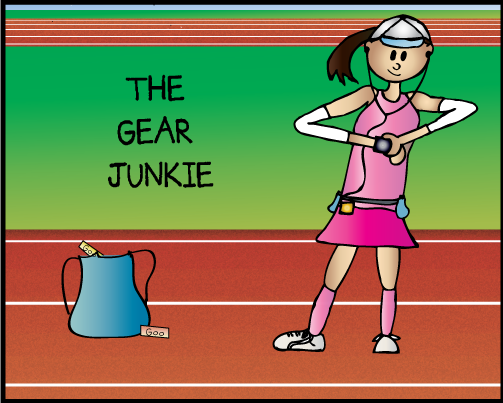Have you noticed that I LOVE running? What started as a hobby after high school to kill time has completely transformed my life.

To really drive this point home, here’s a fun story: even though we’re not super religious, my wife and I took the Pre-Cana course (we had a Catholic ceremony) before we got married.
During the class, we were asked what most concerned us about marriage. And my wife, in front of 30 people, said “I’m worried Jason will always run too much and won’t spend enough time with our family.”
HA! I still tease her about this today.
But it’s true: I really do love running. And one of the big reasons that running appeals to me is because of its simplicity. Just lace up a pair of shoes and you’re ready to go.
You don’t need a team, field or court, or ball. You can run virtually anywhere, with friends or alone. More importantly, even as an adult you can compete almost any weekend of the year in practically any city in the world.
Awesome, right?
And when it comes to running gear, the basics often work best: a pair of running shoes and simple clothes and you’re off to the races (I worked so hard on that pun).
But I think runners today are too focused on their gear. We’ve become obsessed with heart rate monitors and GPS watches. We debate maximalist, minimalist, and actuator lugs.
The latest gizmo promises real-time accurate lactate testing, biosignal sensing, and VO2 Max monitoring.
Am I the only one who realizes that 99% of the progress you make as a runner has NOTHING to do with all this stuff?
Yes, it’s pretty damn cool.
Yes, these toys are fun to play with if you have the resources and time.
But they’re not necessary. Even though I recognize they’re a lot of fun, most runners simply don’t need any of these gadgets.
Today I want to offer a few simple suggestions for running gear – that won’t cost you four figures and require a mechanical engineering degree to understand.
Instead, let’s prioritize the “big wins” of running so we can boost our fitness, run faster than we ever have before, and focus on enjoying the process of training.
These are excerpts from my book 101 Simple Ways to be a Better Runner.
If this approach appeals to you, I’d love for you to check it out. It’s also available as an instant download if you don’t have a Kindle reader.
Ready? Let’s do this.
Stop buying such expensive shoes
Dr. Bernard Marti, the leading preventative-medicine specialist at Switzerland’s University of Bern conducted research that showed the most common variable among injured runners wasn’t training volume, the intensity of workouts, or frequency of races. It was the price of their running shoes. Runners who paid more than $95 for their trainers were more than twice as likely to get hurt.
Expensive running shoes tend to have all the bells and whistles: a very elevated heel, lots of motion-control “technology,” and plenty of “shock guidance systems.” They haven’t been proven to help you run faster or keep you healthy, but you’ll sure pay extra for them.
Stick to shoes that are generally in the $80 or less price category. They tend to have fewer motion-limiting features that tend to increase your risk of injury.
Additional Resource:
- Strength Running’s growing collection of shoe reviews
Want a home gym for $20?
Gym memberships are expensive. The average person pays about $500 annually to belong to their gym and more than half of people over-estimate how many times they’ll visit the gym when they first sign up.
Instead, get a 10-12 pound medicine ball. You can do a full body workout in ten minutes by doing simple exercises like lunges, squats, dead lifts, chest press, and ab work with a med ball. Many exercises can be done standing up – perfect for runners who should be doing some of their strength work while standing (it mimics the demands of running).
Additional Resources:
- The Tomahawk Medicine Ball Workout
- The ball I personally use: Valeo Medicine Ball
Heart-rate monitors don’t make you faster
Too many runners think they need the fanciest gear to help them get faster. Heart rate monitors aren’t necessary to be a good runner, but they can be a useful training tool for a more advanced runner.
There are two specific types of workouts that lend themselves very well to heart rate training: recovery runs and tempo runs. It’s important to make recovery runs truly easy so a heart rate monitor can keep you honest and make sure you’re not working too hard.
Tempo workouts are typically run at about 85-90% of your maximum heart rate. You can use a heart rate monitor to determine your max heart rate and then work at the correct percentage. It may not be completely accurate, but it can be a valuable tool to help inform your workouts.
Additional Resource:
Keep a Training Log
As the wise saying goes, “What gets measured gets managed.” Besides being a valuable learning tool, you’ll be thankful that you have records of what you did every day later in life. Talk about a helluva heirloom for your grandkids!
You can choose to use a hard copy training journal – any notebook will work – but there are also online options for you. Websites like www.dailymile.com or www.runnersworld.com/log are very popular. And of course, a plain old Excel spreadsheet works fine too.
By using a training log, you can look back at your training to see how you were able to run such a fast race or find the errors in your running that led to a poor performance. If you don’t have the past records, how will you know?
Change into a pair of minimalist shoes when you run workouts
One of the most beneficial times to run in minimalist shoes is when you’re running fast. This is an advanced technique but will help you build foot and lower leg strength to help you prevent injuries. You’ll also reinforce an efficient running stride, helping you improve your economy.
Remember that this is an advanced strategy so if you’re not comfortable with racing flats, spikes, or other minimalist shoes you should first start by running easy in them. Once you’re ready to wear flats for a workout, do your warm-up and warm-down in your regular trainers and reserve your “fast shoes” for the fast portion of the workout.
Additional resources:
- How to transition to minimalist shoes
- My collection of casual minimalist shoes
The Most Important Advice about Running Gear

Even if you describe yourself as a gear junkie, recognize that the vast majority of fitness gains come from training correctly – not the gear you have.
You could buy the latest Nikes and a $1,000 NBA game ball but that won’t make you Michael Jordan.
And similarly, the latest biometric monitoring device and analytic software won’t make you Mo Farah.
So focus on the fundamentals: smart training, consistency, and staying healthy. Become a better athlete, get stronger, and never stray from any single training stimulus.
Soon, you’ll be outpacing your gear junkie friends as they fiddle with their foot pods.
Want more actionable, bite-sized pieces of running advice? Pick up my book on Amazon here or as an instant download here.
Now I’m curious – even though I have a love-hate relationship with running gear, I want to know what your favorite piece of equipment is right now. What can’t you run without?
Leave a comment below and let me know!